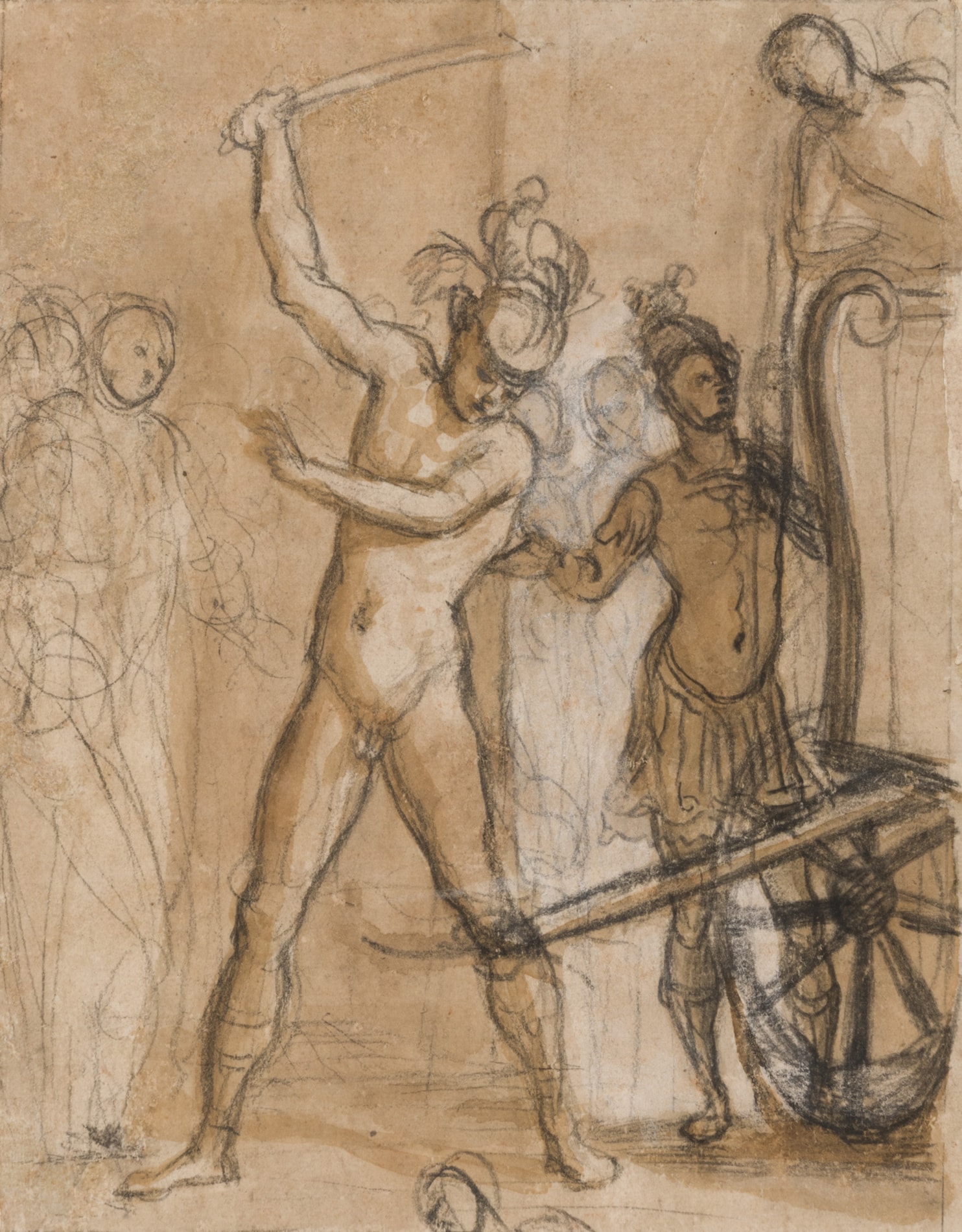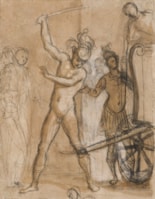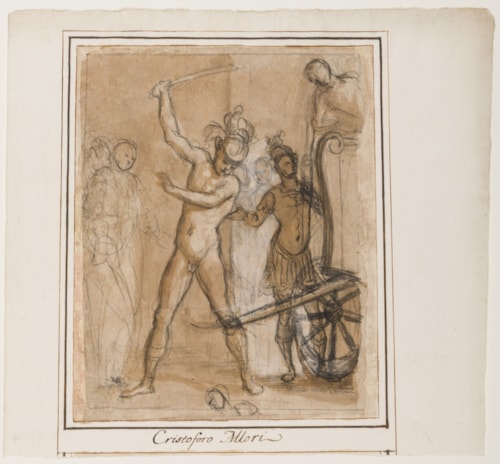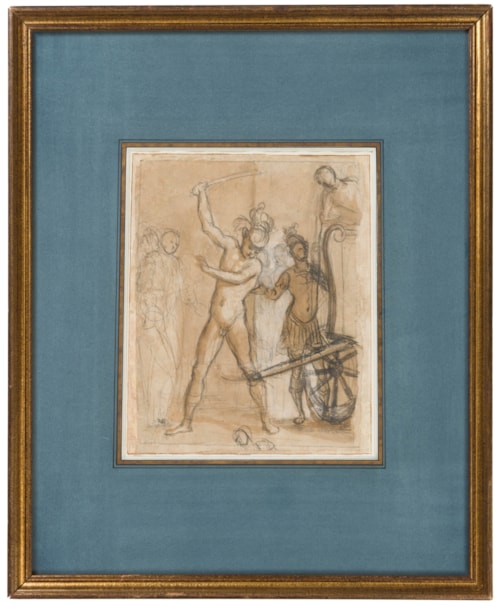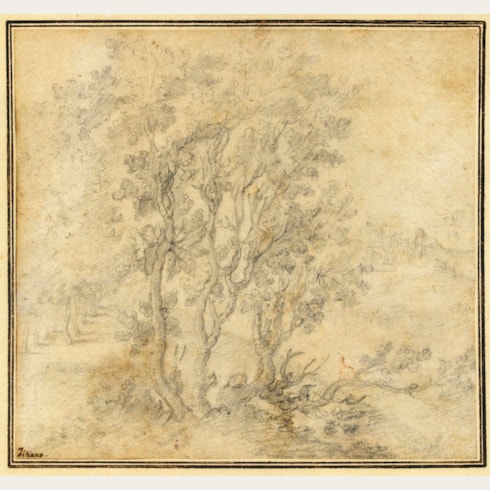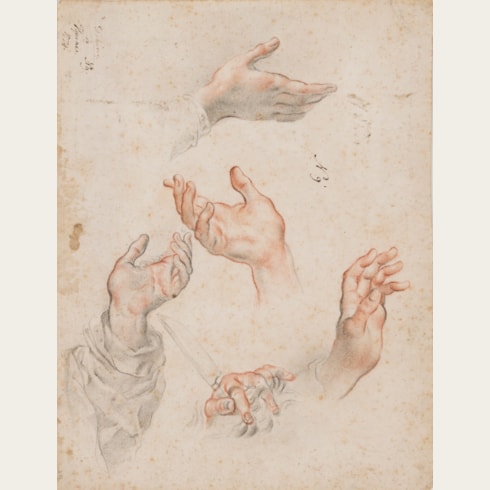Cristofano ALLORI
(Florence 1577 - Florence 1621)
Alexander the Great Cutting the Gordian Knot
Black chalk and brown wash, heightened with white.
Laid down on a 17th or 18th century Italian mount, inscribed (by Niccolò Gabburri?) Cristoforo Allori in the lower margin.
Further inscribed Coll. Gaburri on the reverse of the mount.
231 x 188 mm. (9 1/8 x 7 3/8 in.)
Laid down on a 17th or 18th century Italian mount, inscribed (by Niccolò Gabburri?) Cristoforo Allori in the lower margin.
Further inscribed Coll. Gaburri on the reverse of the mount.
231 x 188 mm. (9 1/8 x 7 3/8 in.)
The present sheet has been attributed to Cristofano Allori since the late 17th or early 18th century. While the slender, graceful pose of the central figure is typical of Allori, the technique is unusual for the artist, who worked mainly in black or red chalk, although he occasionally used pen and ink for compositional studies. A stylistic comparison may nevertheless be made with a handful of pen and wash drawings, including two studies of kneeling figures, among the large corpus of drawings by Allori in the Uffizi in Florence.
The story of the Gordian Knot is taken from ancient Greek legend, and tells of an ox-cart, tied to a post with a highly intricate knot, in the palace of the former Phrygian kings in the city of Gordion. Local legend had said that whoever was able to unravel the knot would one day rule over all of Asia. In 333 BC Alexander the Great marched through Phrygia, and at Gordion attempted to untie the elaborate knot. Having failed to do so, he simply took his sword and cut through it with one stroke.
The inscription on the mount on which this drawing is laid down is similar to those found on several drawings by Florentine and Tuscan artists from an album formerly in the collection of Comte Eugène Charles d’Oultremont (1845-1916) in Belgium. The d’Oultremont album was in all likelihood originally compiled in Florence in the 17th or 18th century, possibly by the Florentine diplomat, collector and biographer Francesco Maria Niccolò Gabburri (1676-1742). A number of drawings sharing this provenance, and with similar mounts and inscriptions, are in the Louvre.
An earlier provenance for this drawing is suggested by a number of Florentine drawings – in particular a large group by Baldassare Franceschini, known as Volterrano - with the same later d’Oultremont provenance as the present sheet which are inscribed in the distinctive handwriting of the 17th century Florentine engineer, draughtsman and collector Giuseppe Santini, who was active between c.1661 and 1717.
The story of the Gordian Knot is taken from ancient Greek legend, and tells of an ox-cart, tied to a post with a highly intricate knot, in the palace of the former Phrygian kings in the city of Gordion. Local legend had said that whoever was able to unravel the knot would one day rule over all of Asia. In 333 BC Alexander the Great marched through Phrygia, and at Gordion attempted to untie the elaborate knot. Having failed to do so, he simply took his sword and cut through it with one stroke.
The inscription on the mount on which this drawing is laid down is similar to those found on several drawings by Florentine and Tuscan artists from an album formerly in the collection of Comte Eugène Charles d’Oultremont (1845-1916) in Belgium. The d’Oultremont album was in all likelihood originally compiled in Florence in the 17th or 18th century, possibly by the Florentine diplomat, collector and biographer Francesco Maria Niccolò Gabburri (1676-1742). A number of drawings sharing this provenance, and with similar mounts and inscriptions, are in the Louvre.
An earlier provenance for this drawing is suggested by a number of Florentine drawings – in particular a large group by Baldassare Franceschini, known as Volterrano - with the same later d’Oultremont provenance as the present sheet which are inscribed in the distinctive handwriting of the 17th century Florentine engineer, draughtsman and collector Giuseppe Santini, who was active between c.1661 and 1717.
The son and pupil of the painter Alessandro Allori, Cristofano Allori became one of the leading artists of the early Baroque in Florence. His earliest known works are portrait commissions of members of the Medici family, painted in the 1590’s and indebted to the example of the paintings of his father and of Bronzino. From 1600 Allori came under the influence of such artists as Ludovico Cigoli and Domenico Passignano, whose work was a rejection of the hard, cold style of Bronzino and the elder Allori, and moved towards a more naturalistic and less mannered style of painting. Around this time Cristofano left the studio of his father and began working with Gregorio Pagani, as well as assisting Cigoli on the decoration of some rooms in the Palazzo Pitti, and Cigoli’s influence was to be particularly pervasive on the young man’s work.
The early years of the 17th century found the artist also much admired as a portrait painter, his work in this field typified by the Portrait of Bernardo Davanzati of c.1605 in the Ashmolean Museum in Oxford. From 1605 until his death in 1621, Allori was one of the most successful painters in Florence, counting among his patrons the Grand Duke Cosimo II de’ Medici and other members of the Ducal court. Among the significant works of this period were a ceiling painting of The Embarkation of Marie de’ Medici in the church of the Cavalieri di Stefano in Pisa, completed in 1605, and a massive Resurrection for the cathedral of Pistoia, on which he worked between 1602 and 1610. The last decade of his career found the artist painting religious easel pictures characterized by an intense emotionalism, graceful movement and superb draughtsmanship, notably the Judith with the Head of Holofernes of c.1615, in which the severed head is a self-portrait. Among Allori’s pupils were Giovanni Battista Vanni and Zanobi Rosi.
Provenance
An anonymous 17th or 18th century Florentine collection, possibly that of Giuseppe Santini, Florence
Francesco Maria Niccolò Gabburri, Florence
Comte Eugène Charles d’Oultremont, Château de Presles, Aiseau-Presle, Belgium
Thence by descent until c.1985
Marcello Aldega, Rome, and Margot Gordon, New York, in 1990
Private collection, England
Anonymous sale, London, Christie’s, 2 July 2019, lot 48 (as Giovanni Bilivert)
Anonymous sale, New York, Sotheby’s, 29 January 2020, lot 31.
Francesco Maria Niccolò Gabburri, Florence
Comte Eugène Charles d’Oultremont, Château de Presles, Aiseau-Presle, Belgium
Thence by descent until c.1985
Marcello Aldega, Rome, and Margot Gordon, New York, in 1990
Private collection, England
Anonymous sale, London, Christie’s, 2 July 2019, lot 48 (as Giovanni Bilivert)
Anonymous sale, New York, Sotheby’s, 29 January 2020, lot 31.
Literature
New York, Margot Gordon and Rome, Marcello Aldega, Old Master Drawings, exhibition catalogue, 1990, pp.42-43, no.16.
Exhibition
New York, Margot Gordon and Rome, Marcello Aldega, Old Master Drawings, 1990, no.16.

